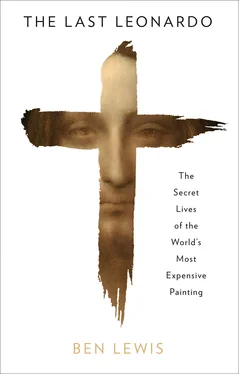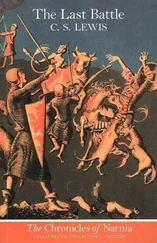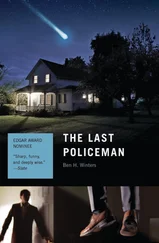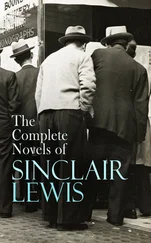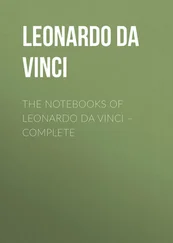This artist, Leonardo da Vinci, was just like the sun. He was the brightest planet in the art history cosmos. Scholars who flew too close to him found their books suddenly aflame and themselves engulfed in the fire of ambition. Yet still their attempts continued …
PART I
CHAPTER 1
Flight to London
Robert Simon had plenty of legroom on his flight to London in May 2008. He was flying first class, an unusual luxury for this comfortably successful but unostentatious Old Masters dealer, president of the invitation-only American Private Art Dealers Association. During moments of transatlantic turbulence he cast a glance down the aisle at one of the first class cabin’s cupboards, where he had been given permission to stow a slim but oversized case.
It contained a Renaissance painting, 66cm high and 45cm across, of a ‘half-figure’, to use the old-fashioned art historical term, of Christ. The portrait composition showed the face, chest and arms, with one hand raised in blessing and the other holding a transparent orb. One reason Simon was worried about the painting was because he had not been able to afford the insurance premium he had been quoted for it. He had bought it three years earlier for around $10,000 – or so he had told the media – but it was now thought to be worth between one and two hundred million dollars.
Far from being the life of luxury many people imagine, dealing in art can be a precarious existence even at the highest levels, because selling expensive paintings is, well, very expensive. Top-end galleries have vertiginous overheads. Walls have to be repainted for each show, catalogues printed, wealthy collectors wined and dined. Simon had spent tens of thousands of dollars restoring the boxed painting, and had not yet seen a penny return.
Solidly built, medium height, Jewish, fifty-something, soft-spoken, polite, Robert Simon is the kind of person who believes that modesty and understatement are rewarded by the higher forces which direct our lives. He projects a modest, pleasant, but slightly brittle calm. ‘Loose lips sink ships,’ he likes to say, repurposing a slogan emblazoned on American propaganda posters in the Second World War to the business of art.
Simon leant backwards in his seat. He was overcome by that mood men fall into when they know the die has been cast, the pieces arranged on the board, and there is nothing more they can do except perform a sequence of now predetermined actions. There could be no more organising, influencing, persuading. It was all done, to the best of his abilities. The confinement of the long pod of the aircraft cabin and the sensation of forward motion provided by the thrust of four jet engines combined into a physical metaphor for this moment in his life.
Alongside the submarine, the parachute and the machine gun, the aeroplane was the most famous invention anticipated by the artist who had consumed Simon’s life for the previous five years. Leonardo da Vinci was not the first human who had designed flying machines, and it is likely he never built one himself, but he had studied the subject for longer, written more, and drawn designs of greater sophistication than anyone before him. His ideas for human flight were based on years of watching and analysing the airborne movements of birds, bats and flying insects, and recording his observations in notes and drawings. As Simon felt air currents lifting up the plane, he recalled how Leonardo was the first to recognise that the movement of air was as important to a bird’s flight as the movement of its wings.
On 15 April 1505 Leonardo completed a draft treatise On the Flight of Birds , also known as the Turin Codex . It was only about forty pages long, filled with unusually neat lines of text, written in black ink in his trademark mirrored handwriting, right to left, interspersed with geometric diagrams, and the margins sometimes decorated with tiny, beautiful sketches of birds in flight. Leonardo’s early ornithopters , or ‘birdcraft’, had wings shaped like a bat’s, because, as he wrote, a bat’s wing has ‘a permeable membrane’ and could be more lightly constructed than ‘the wings of feathered birds’, which had to be ‘more powerful in bone and tendon’. Leonardo positioned his pilot horizontally in a frame underneath the two wings, where he was to use his arms and legs to push a system of rods and levers to make them flap. Historians say Leonardo soon came to realise that the human body was too heavy, and its muscles too weak, to provide enough power for flight, so his later designs had fixed wings and were more like gliders. He imagined launching one, appropriately, from a mountain ‘named after a great bird’, referring to Monte Ceceri, or ‘Mount Swan’, in Tuscany. Relishing the avian metaphors, Leonardo wrote that his ‘great bird will take its first flight on the back of the great swan, filling the universe with amazement, filling all writings with its renown and bringing glory to the nest in which it was born’. Nothing he designed ever flew. The contraptions were almost daft, but there was prophetic genius in his perception of the natural phenomena and laws of nature which gave rise to his machines.
Robert Simon knew that, whatever the outcome of this trip – and that really could be everything or nothing – it marked the pinnacle of his career to date in the art world. If everything went well, he would probably earn a place in the art history books. If not, he would remain respected but unexceptional. This flight also represented the apogee of something more personal. In common with most art dealers, there was a motivation behind his career which had nothing to do with money or success, and which had shaped his life for somewhat longer: an unconditional, unrelenting love for art; not modern and contemporary art with its splodges, squiggles and splats, but the great art of the past, especially the Renaissance, in which the eternal stories of the Bible and of Ancient Greece and Rome were brought to life by the melodramatic gestures of bearded men and golden-haired women, amidst thick gleaming crumples of silk and satin cloth, set against a classical backdrop of esplanades and porticos, temples and fortresses.
When he was fifteen, Simon went on a school trip to Italy. He remembers the winding roads of the hills around Florence, the low sun flashing through the cypress trees as the bus drove towards the town of Vinci, the birthplace of Leonardo da Vinci, from Vinci. (By coincidence, my parents would take me on a similar trip in my own teenage years.) ‘Leonardo has been my deity for most of my life – and I am not alone,’ Simon told me. ‘He’s my idea of the greatest person that civilisation has produced.’ Over the decades Simon had seen every major Leonardo exhibition that had been staged, and every Leonardo painting, and ‘as many drawings as I could’. His professional life, which now revolved around Leonardo, had taken him once before into the artist’s sphere, in 1993, when he was asked to examine the Leicester Codex , one of Leonardo’s revered manuscripts, for its owners. It is now owned by Bill Gates, but then belonged to the oil magnate Armand Hammer’s foundation.
Simon’s family were well-to-do but had not been deeply involved in art. His father was a salesman of eyeglasses. Simon was sent to an exclusive, academically orientated high school, Horace Mann School, in the New York suburb of Riverdale. Afterwards he specialised in medieval and Renaissance studies, and then art history, at Columbia University. He wrote his PhD on a newly discovered painting by the sixteenth-century Italian Mannerist painter Agnolo Bronzino, held in a private collection. A portrait of the Florentine Medici ruler Cosimo I in gleaming armour, it was known from the many copies, around twenty-five of them, which hung in museums and homes, or sat in storerooms around the world. Art historians had long considered that the original work was the one in the Uffizi, Florence’s famous museum. However, in a story with uncanny parallels to that of the painting that he was now taking to London, the young Simon had argued that he had identified an earlier original of this painting, the owners of which wished to remain anonymous. He published an article about it in the esteemed journal of connoisseurship and painting, the Burlington Magazine . 1The painting now hangs in an Australian museum, as a Bronzino, although some experts still believe it was painted by the artist’s assistants.
Читать дальше
